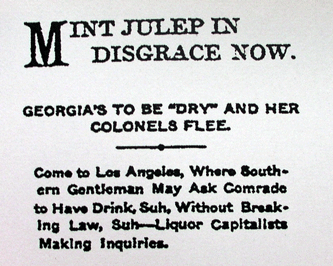
Los Angeles
Colonel and Cracker alike are swarming our borders!
Dateline—The Peach State—Sherman’s march to the coast was less an indignity than that done by the last state election: all liquor establishments are to be outlawed on January 1. Now the march is of capital out of Georgia—an estimated $3,000,000 in taxes and licenses in 08. As the steady, self-righteous hand of the WCTU has not as yet clamped itself upon the great metropolis of Los Angeles, wholesalers and barmen alike are arriving en masse.
Those in the LA liquor trade welcome our Reb brethren, at least so that they may assure their bit by securing locations and concessions for the newcomers. The local liquor lobby has hit up City Hall for an extension of the Liquor Zone, and has petitioned to increase the number of saloons in LA to 250.
Despite a collective Angeleno fondness for drink, it is the civic duty of 1947project to provide a temperance lesson:
Some years ago, Harry Stuart was a pugilist of renown, his nose broken repeatedly in the ply of his noble trade. Then, as a barkeep on West Third, he was LA’s authority on the pugilistic arts, and oft served as referee for Tom McCarey’s Fight Club, which held forth in the old Hazard’s Pavilion (in 1907 the site of the great Auditorium facing Central Park). Stuart was famous for the way he yelled “b-r-e-a-k!” that amused spectators; his downfall was an unpopular decision in the ring which awarded a trophy to colored boxer Billy Woods, over Al Neil.
Bad luck turned worse after Stuart built a fight club at the westerly end of the Third Street tunnel, which prompted uproar from the tony neighbors. The City Council passed an ordinance confining such clubs to a certain district in the Eighth Ward. To make matters all the more discouraging, Stuart was stung by a spider on his left eye, destroying the sight thereof.
He found menial employment soliciting monies for a weekly publication, and after collecting nearly $100 ($2,052 USD 2006), decided to go on the drinking spree to end all drinking sprees. It lasted three weeks.
After the money was gone and the booze was consumed, he wrote notes to his wife in San Francisco, the Los Angeles Coroner, and his employer. In them he stated that drink had put him “down and out” and that he had nothing to live for. From his note to the Coroner: “Booze has been the cause of my downfall, and I am daffy…my wife will meet the expense of having my worthless body burned.”
Stuart, after losing his last fight, this one to a bottle, swallowed a solution of bromide in his Bunker Hill room at 244 North Grand.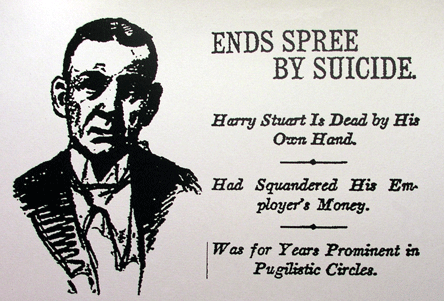

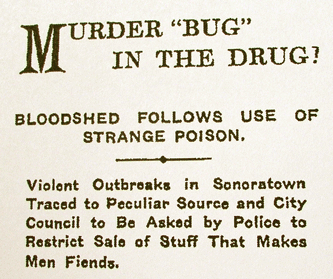


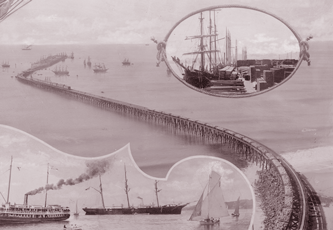 The great wharfs and piers of Los Angeles are by and large but a thing of memory. Who cannot tilt a head in wonder as one motors up PCH past the State Historic Landmark signage for the Port of Los Angeles Long Wharf, designating it “site of” the longest wooden pier in the world?
The great wharfs and piers of Los Angeles are by and large but a thing of memory. Who cannot tilt a head in wonder as one motors up PCH past the State Historic Landmark signage for the Port of Los Angeles Long Wharf, designating it “site of” the longest wooden pier in the world?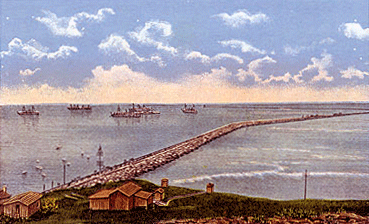
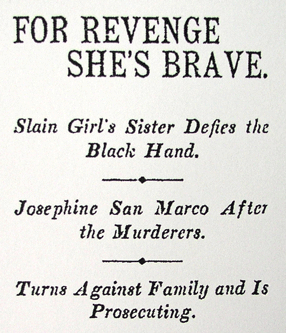

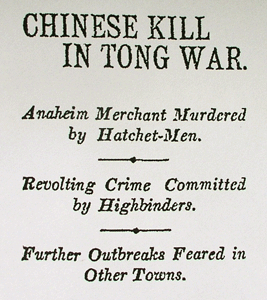

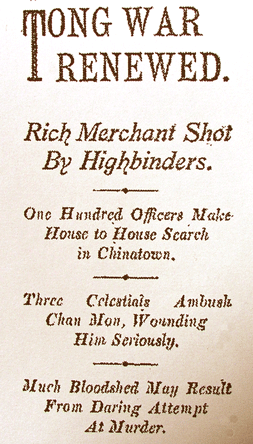
 July 13, 1907
July 13, 1907
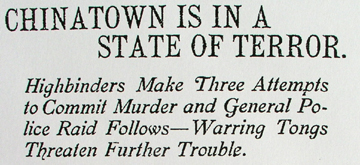
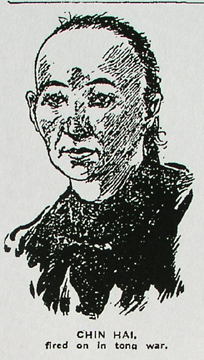
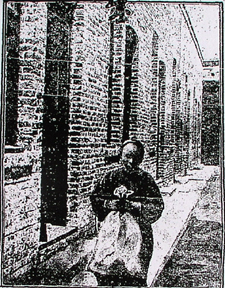 The young and fair Ling Auk, left, who had been friendly to the Bing Gon, was surprised by Hop Sing hatchetmen on June 19. Luckily, they were scared away by her protectors. The Hop Sing Tong has always been the most warlike in the Chinese settlement. They are centered at 529+1/2 North Los Angeles Street, where they have built a walled fortress replete with intricate tunnels that repeatedly prevent their capture. That White girls retire there to smoke opium is a sad, accepted fact of modernity.
The young and fair Ling Auk, left, who had been friendly to the Bing Gon, was surprised by Hop Sing hatchetmen on June 19. Luckily, they were scared away by her protectors. The Hop Sing Tong has always been the most warlike in the Chinese settlement. They are centered at 529+1/2 North Los Angeles Street, where they have built a walled fortress replete with intricate tunnels that repeatedly prevent their capture. That White girls retire there to smoke opium is a sad, accepted fact of modernity. 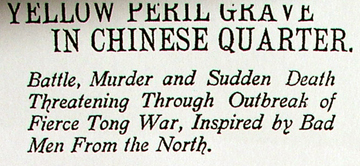
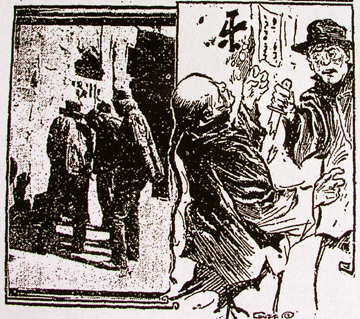
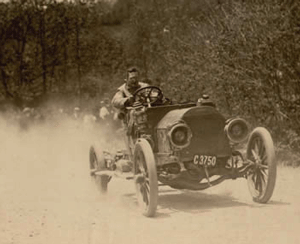
 The other day officers saw a man blazing down Pico in his autoed-mobile and gave chase for two miles. He was arrested, promised to show for court, and of course did not.
The other day officers saw a man blazing down Pico in his autoed-mobile and gave chase for two miles. He was arrested, promised to show for court, and of course did not.
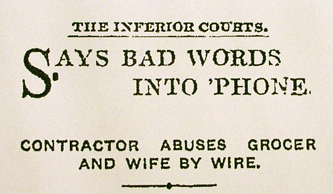
 John Richie, contractor of East Fourteenth Street, has an unsavory record. Richie used to, daily, beat his son with a rake handle, until such time as the boy became an idiot. This finally drove Richie’s wife insane, and she died in an asylum, whereafter Richie got drunk and danced about in the room where the casket had been placed.
John Richie, contractor of East Fourteenth Street, has an unsavory record. Richie used to, daily, beat his son with a rake handle, until such time as the boy became an idiot. This finally drove Richie’s wife insane, and she died in an asylum, whereafter Richie got drunk and danced about in the room where the casket had been placed.